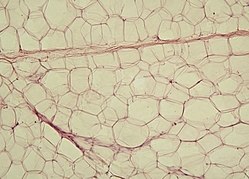Preadipocyte
| Adipocyte | |
|---|---|

Yellow adipose tissue in paraffin section
|
|
| Details | |
| Identifiers | |
| Latin | adipocytus |
| Code | TH H2.00.03.0.01005 |
|
Anatomical terminology
[]
|
|
Adipocytes, also known as lipocytes and fat cells, are the cells that primarily compose adipose tissue, specialized in storing energy as fat.
There are two types of adipose tissue, white adipose tissue (WAT) and brown adipose tissue (BAT), which are also known as white fat and brown fat, respectively, and comprise two types of fat cells. Most recently, the presence of beige adipocytes with a gene expression pattern distinct from either white or brown adipocytes has been described.
White fat cells or monovacuolar cells contain a large lipid droplet surrounded by a layer of cytoplasm. The nucleus is flattened and located on the periphery. A typical fat cell is 0.1 mm in diameter with some being twice that size and others half that size. The fat stored is in a semi-liquid state, and is composed primarily of triglycerides and cholesteryl ester. White fat cells secrete many proteins acting as adipokines such as resistin, adiponectin, leptin and apelin. An average human adult has 30 billion fat cells with a weight of 30 lbs or 13.5 kg. If excess weight is gained as an adult, fat cells increase in size about fourfold before dividing and increasing the absolute number of fat cells present.
Brown fat cells or plurivacuolar cells are polygonal in shape. Unlike white fat cells, these cells have considerable cytoplasm, with lipid droplets scattered throughout. The nucleus is round, and, although eccentrically located, it is not in the periphery of the cell. The brown color comes from the large quantity of . Brown fat, also known as "baby fat," is used to generate heat.
...
Wikipedia
